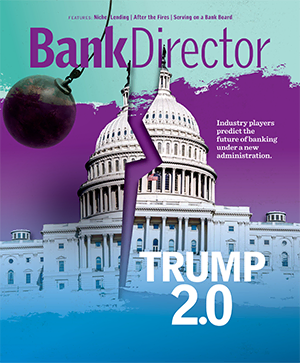Kiah Lau Haslett is the Banking & Fintech Editor for Bank Director. Kiah is responsible for editing web content and works with other members of the editorial team to produce articles featured online and published in the magazine. Her areas of focus include bank accounting policy, operations, strategy, and trends in mergers and acquisitions.

Crafting Your Data Strategy
The pace of technological innovation is accelerating. Creating and executing a data strategy today allows community financial institutions to be prepared for an uncertain future.
Brought to you by Wealth Access Inc.

The following piece is from FinXTech’s latest intelligence report, “Crafting Your Data Strategy,” sponsored by Wealth Access. Access the full report here.
Community financial institutions have the potential to unlock greater labor efficiencies, new revenue opportunities and better risk management.
The key to achieving these outcomes? Data.
That’s because better data can lead to better decisions, which can help executives achieve operating leverage and improve efficiency. But much of that data has been stored as entries that need to be cleaned and standardized in disparate, unconnected systems. The work to extract and format the data is akin to an archeologist who starts digging and then will need to survey, identify, extract and clean their artifacts so they can decide what’s trash and what’s treasure.
Creating and executing an effective data strategy is imperative for executives, given how technology is changing banking. Community financial institutions are at a pivotal junction: There is a daunting amount of work to be done, but there are untold possibilities on the other side. The data is there, the tools are available and there is even something of a playbook for institutions to follow to make the journey smoother.
“Smaller banks now have an opportunity to start seeing the big picture about their clients like big banks do,” says Andy Zinn, chief innovation officer at Wealth Access. “Even though they don’t have the $100 million-a-year tech budget, they’re able to … broaden the scope of what they can see within their own four walls.”
Blind Spots
Sonata Bank in Brentwood, Tennessee, started its data journey early in its operation, after the institution was recapitalized by an investor group in 2022. This has arguably given the $222 million bank, a unit of Sonata Financial Holdings, a competitive advantage among its peers.
Management knew that data was going to be a large part of its strategy and execution — and could even be an area it potentially monetized, especially as they thought about how to serve their niche market of quick service restaurant owners and workers, says Will Rhoads, Sonata’s chief innovation officer. This focus comes as community financial institution executives across the U.S. have become more serious about utilizing their data over the past decade, he says. Still, Rhoads sees varying levels of maturity and sophistication across institutions.
“Many [community banks] today are leveraging data for things like risk management, fraud detection and compliance reporting, but they’re not using it for proactive decision-making,” he says. “They’re living in an environment where their data is siloed across all these different systems … that makes it hard to really pull all [the data] into one location.”
In Bank Director’s 2024 Technology Survey, 34% of respondents reported that they were in the early stages of their data strategies, using data in just a few areas of operations, while 40% reported they use data in several areas of their institutions but still saw significant room for improvement. Sixteen percent reported not having a data strategy.
One reason why Rhoads thinks small institutions struggle is because their data is in a format or location they can’t leverage to create meaningful efficiencies or greater growth opportunities. Technology of yesteryear, it seems, has created many of the data problems that banks need to solve today. To that end, Sonata started a project in 2024 to bring all its data into a data lake house. A data lake house is a data architecture platform that combines the flexible storage aspects of data lakes with the structure and management of data warehouses.
“A uniquely American challenge, I would say, is our banking architecture and systems are archaic relative to our peers in other jurisdictions,” says Mohammad Nasar, a principal in Crowe’s financial services consulting practice.
There is a “tremendous” amount of data stored in legacy systems, says James White, general manager of banking at customer relationship management software firm Total Expert. Older technology systems could only store data of a certain width, which meant that entries into these systems were constrained, and the rest was discarded. Some files still use 8-bit EBCDIC, or extended binary coded decimal interchange code, used in the IBM mainframe.
Compounding the technology limitations is that most financial institutions are organized through what Nasar calls “a financial product-centric architecture.” Regardless of whether an institution is using its core providers or leveraging third parties and fintechs, most systems are geared towards servicing a specific class of products and are not focused on a broad customer-centric view. Because of that, an institution’s lending division — commercial and consumer — may not be connected to the deposit group, the brokerage division or the trust department and wealth management. These systems store customer data in specific ways, creating information sets in a siloed manner that may have overlapping entries with slight differences that make the dataset unreliable for analytics purposes.
Take, for example, one pernicious data problem financial institutions face: their customer records. Technology companies — ranging from large incumbent firms like online retail giant Amazon.com down to nascent fintech startups — have demonstrated that understanding the customer is key to profitability.
Financial institutions have long sought to cross-sell multiple products to existing customers to increase revenue and grow profitability. But multiple products also create multiple data entries across various systems in the bank: deposit accounts, mortgages, credit cards, car loans, wealth management and potentially even commercial accounts. These products may all have a separate customer record and potentially inconsistent information. For instance, one might require a middle name while another requires an initial, or one might use a shortened nickname while another uses the full name.
“The data of how I relate disparate data about an individual in these different systems to one person or profile or one legal entity can get really challenging and potentially problematic,” Nasar says.
Advances in Technology
If technology created the information silos that banks and credit unions must break down, it will also be the solution for unifying, centralizing and leveraging the data. Small banks and credit unions can add the same capabilities as the biggest financial institutions and tech firms because of the growing number of partners offering data storage and management tools, integrated analytics and visualization applications.
And it’s clear this is an area of growing importance to small institution executives — especially data analytics. According to the 2024 Technology Survey, 80% of respondents said their institution’s leadership team and/or board had discussed allocating budget or resources to data analytics. Only 32% said their bank had upgraded or implemented data analytics platforms and capabilities in the 18 months prior to the survey period of June and July 2024.
These tools may not be new to the market, but they are now available at prices that appeal to community bankers. Executives increasingly believe that while the core stores the institution’s general ledger, it may not be the primary technology partner for their data strategy given the difficulty or expense associated with extracting information from the core. And given the number of options available now, small institutions also don’t have to build these tools in-house to own the process. These outside vendors can help financial institutions unify customer data from disparate systems into one location and then enrich it. The result is a richer, holistic customer profile that institutions can use to personalize their services and cross-sell more effectively. Platforms like Wealth Access allow institutions to analyze data faster and more broadly, meaning executives can make decisions that are more responsive, predictive and dynamic.
At the same time, there are risks that come from sharing bank or customer data with third parties. Executives will need to grapple with issues like data governance, customer privacy and cybersecurity when outsourcing technology services.
Thankfully, smaller financial institutions aren’t wading into uncharted waters. Many financial institutions have executed successful data projects, which creates a playbook for other institutions.
Shikhar Singh saw this firsthand when he left JPMorgan Chase & Co. as an executive director and joined Fargo, North Dakota-based Choice Financial Group as chief technology officer. Big banks like JPMorgan have a significant regulatory burden that requires large amounts of data. Over the years, they’ve invested resources and talent toward data governance, storage and analytics, and now benefit from a flywheel that has spun off applications and use cases.
In contrast, small banks may have historically relied on knowledge gathered through interactions with tellers and being involved in the community to understand their market and customers, with less of a focus on incorporating data in their decision-making. But this is not a sustainable model as an institution grows or expands its reach. That’s what happened when Choice Bank, the $5.6 billion bank unit of Choice Financial, expanded beyond its local customer base and began partnering with fintechs.
“[Community banks] say, ‘Well, we know our customer,’” Singh says. “My question is, ‘If a person is coming through a digital channel, through the fintech customer, do we really know them?’”
Singh’s focus on how Choice Bank’s technology stack integrates with other systems allows the bank to capture, store and use the data generated from these systems. Today, the talent at Choice Bank includes a leader of data analytics who reports to Singh and a data governance function that reports into the bank’s second-line risk function.
“That, to us, was crucial because that’s a good backbone,” he says. “If you don’t have that backbone, then things will crumble down.”
No Time Like the Present
Starting and executing a data strategy is a lot of work, and many smaller firms are early in their journeys. Data projects are too large and unwieldy to do well on accident. There are numerous pitfalls that can negate the return on investment. Putting together and executing a data strategy requires governance, commitment and diligence.
“You got to understand what you want to use these solutions for, whether it’s data, customer relationship management or anything else, before you put the investment in,” says Benjamin Maxim, chief technology officer at MSU Federal Credit Union, which has $8.2 billion in assets and is based in East Lansing, Michigan. “And it is a cultural investment, not a technology investment.”
Perhaps that’s why only 11% of respondents to Bank Director’s 2024 Technology Survey reported their institution uses data in many decisions and areas of their institution and believes their data strategy and execution exceeds peers.
Additionally, data strategies aren’t ever “done” in the narrow project management sense. After implementing a strategy and standing up the data storage and capabilities, the ongoing work is iterative maintenance. Data breeds more questions, and all questions need more data, jokes Dennis Klemenz, chief technology officer at Westbury, New York-based Jovia Financial Federal Credit Union, which has $4.5 billion in assets.
“Where are we on our data journey? I think we’re marching along,” he says. “I would say nobody’s ever done on their journey.”
Wayne Gniewkowski, a principal in Crowe’s financial services consulting practice who focuses on business process, risk and controls, advises clients and prospects about the long timeline
that comes with data and analytics projects — especially if the institution isn’t familiar with its data. These projects are time-consuming and expensive, especially as datasets grow. They can become exponentially more complicated if an institution has a complex business line, like sponsor banking, or has engaged in mergers and acquisitions. That’s all the more reason for institutions to get started now, or to be more diligent in making progress on ongoing projects.
“I’m not saying you have to go supersonic speed with your data, but the longer you wait just to get started, you’re going to find out pretty quickly it’s a bigger lift than most organizations
realize,” he says.
Back at Sonata Bank, Rhoads highlights the importance of small early wins that came from effectively using data analytics and visualizations to build a coalition of stakeholders across the institution. He says the bank’s data projects save employees numerous hours a month that would’ve been spent pulling information and creating reports — important but tedious tasks that aren’t related to deepening customer relationships or growing the bank.
Another catalyst behind the urgency to craft and execute a data strategy is artificial intelligence. Financial institutions interested in leveraging AI should first have “a strong understanding and catalog” of their data, Klemenz writes in a follow-up email. Without those, institutions may reach the limits of their potential AI use cases or use it ineffectively.
“Data warehousing may seem like a 1990s project,” he adds. “But the data from that warehouse is what your AI and machine learning models will use for training.”
The imperative of AI driving data analytics projects speaks to the uncertain technological and operating future that financial institutions face. The pace of technology and innovation is accelerating. Creating and executing a data strategy today allows executives to be more prepared for an uncertain future.
Ultimately, data strategy is about executives defining an institution’s future and setting it up for success. Institutions already on this journey can use this report to gauge their progress, make refinements and think about future use cases. And institutions that haven’t started, or are in their earliest stages, can use it to inform or bolster these efforts. But they need to start — soon, if not today.
“The hardest part is getting started — gaining an understanding of your data, the talent you have, or don’t have, in your organization, and the technology you have or will need,” Gniewkowski says. “There is a lot to assess enterprise-wide.”



